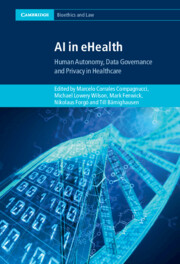Book contents
- AI in eHealth
- Cambridge Bioethics and Law
- AI in eHealth
- Copyright page
- Contents
- Contributors
- Preface
- Acronyms
- 1 Mapping the Digital Healthcare Revolution
- Part I Platforms, Apps and Digital Health
- Part II Trust and Design
- 5 Privacy Management in eHealth Using Contextual Consenting
- 6 Artificial Intelligence and Data Protection Law
- 7 AI Technologies and Accountability in Digital Health
- Part III Knowledge, Risk and Control
- Part IV Balancing Regulation, Innovation and Ethics
- Index
- Cambridge Bioethics and Law
- References
7 - AI Technologies and Accountability in Digital Health
from Part II - Trust and Design
Published online by Cambridge University Press: 08 September 2022
- AI in eHealth
- Cambridge Bioethics and Law
- AI in eHealth
- Copyright page
- Contents
- Contributors
- Preface
- Acronyms
- 1 Mapping the Digital Healthcare Revolution
- Part I Platforms, Apps and Digital Health
- Part II Trust and Design
- 5 Privacy Management in eHealth Using Contextual Consenting
- 6 Artificial Intelligence and Data Protection Law
- 7 AI Technologies and Accountability in Digital Health
- Part III Knowledge, Risk and Control
- Part IV Balancing Regulation, Innovation and Ethics
- Index
- Cambridge Bioethics and Law
- References
Summary
How to build an ecosystem of trust in digital health? The availability of large amounts of personal data, combined with AI and ML capacities, Internet of Things and strong computational platforms, has the potential to transform healthcare systems in a disruptive way. The emergence of personalised medicine offers opportunities and raises new legal, ethical and societal challenges. A silent shift towards data-driven preventive and personalised medicine may improve diagnosis and therapies while reducing public health costs. In order to build trust, risks such as data breaches, privacy issues, discrimination and eugenics must be addressed. This chapter presents the disruptive nature of AI and ML technologies in healthcare, and makes specific recommendations to build a trustworthy digital health system. Special attention is given to governance by international institutions as well as key principles like transparency, accountability and decision-making processes in a medical context. We first identify the key parameters to advance the field of digital health in a responsible way. Second, we propose possible solutions to shape a sound policy in digital health taking into account a rights-based governance framework. The last part of the chapter is dedicated to the accountability scheme.
Keywords
- Type
- Chapter
- Information
- AI in eHealthHuman Autonomy, Data Governance and Privacy in Healthcare, pp. 166 - 206Publisher: Cambridge University PressPrint publication year: 2022
References
- 2
- Cited by

